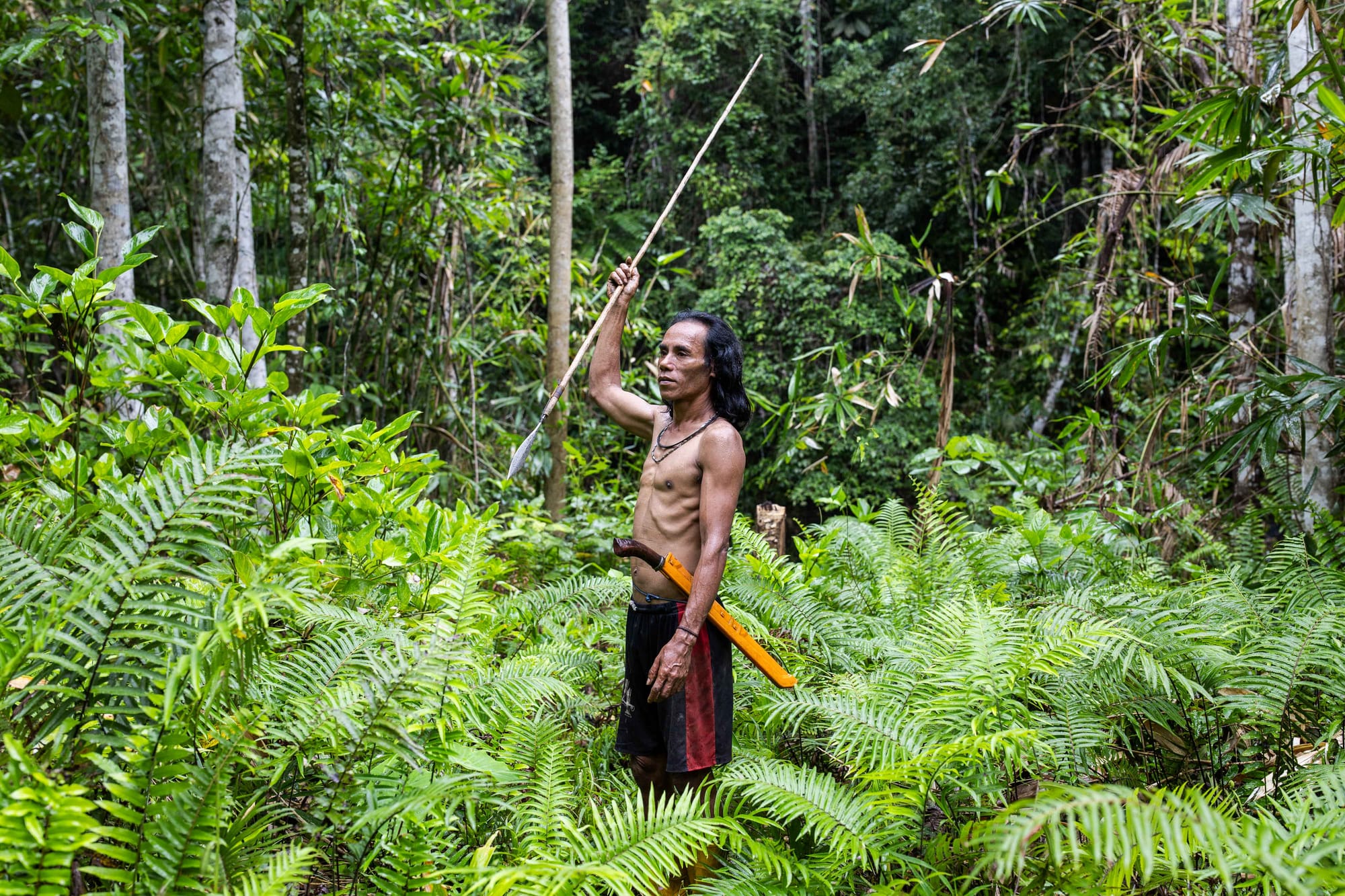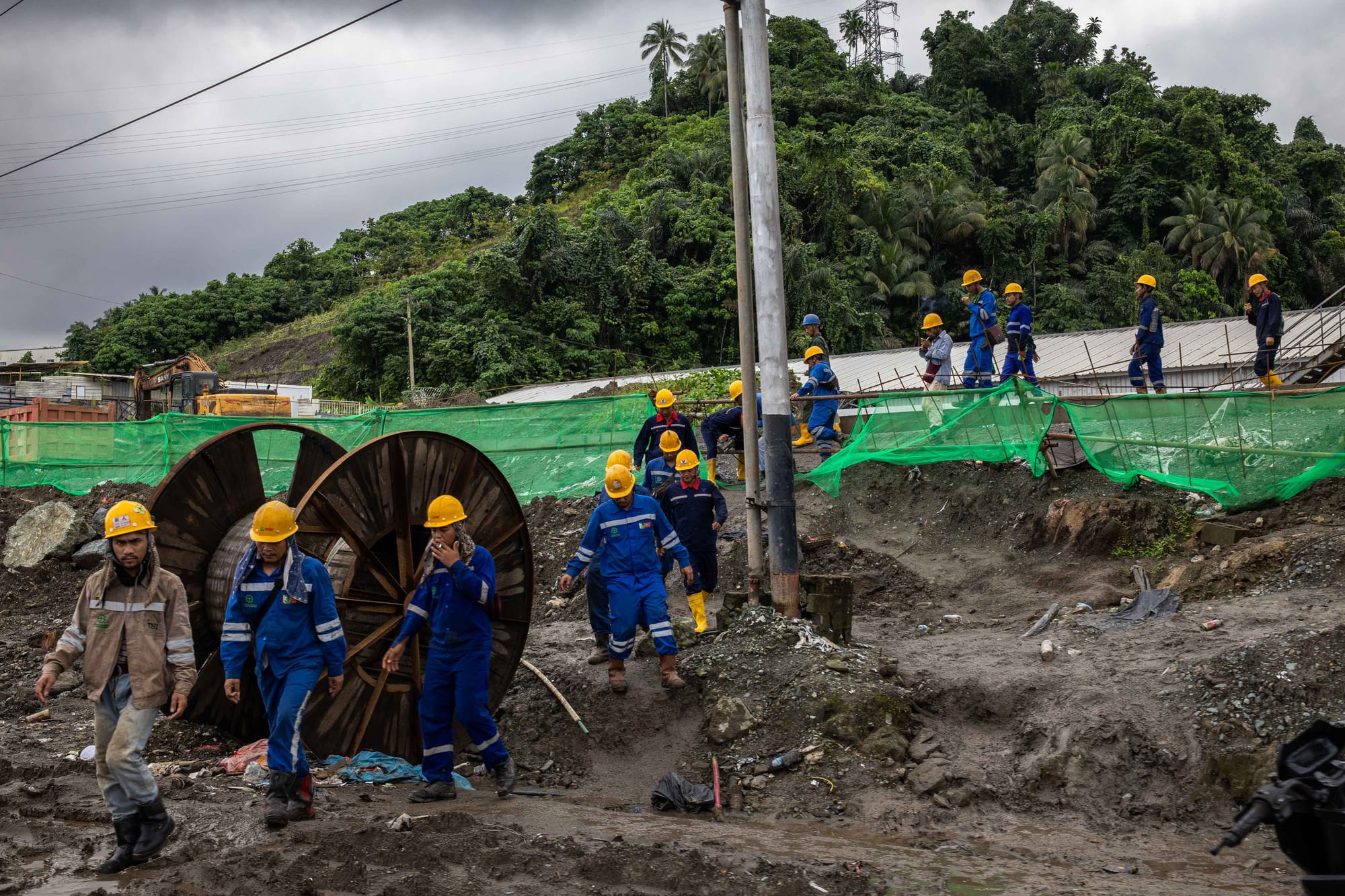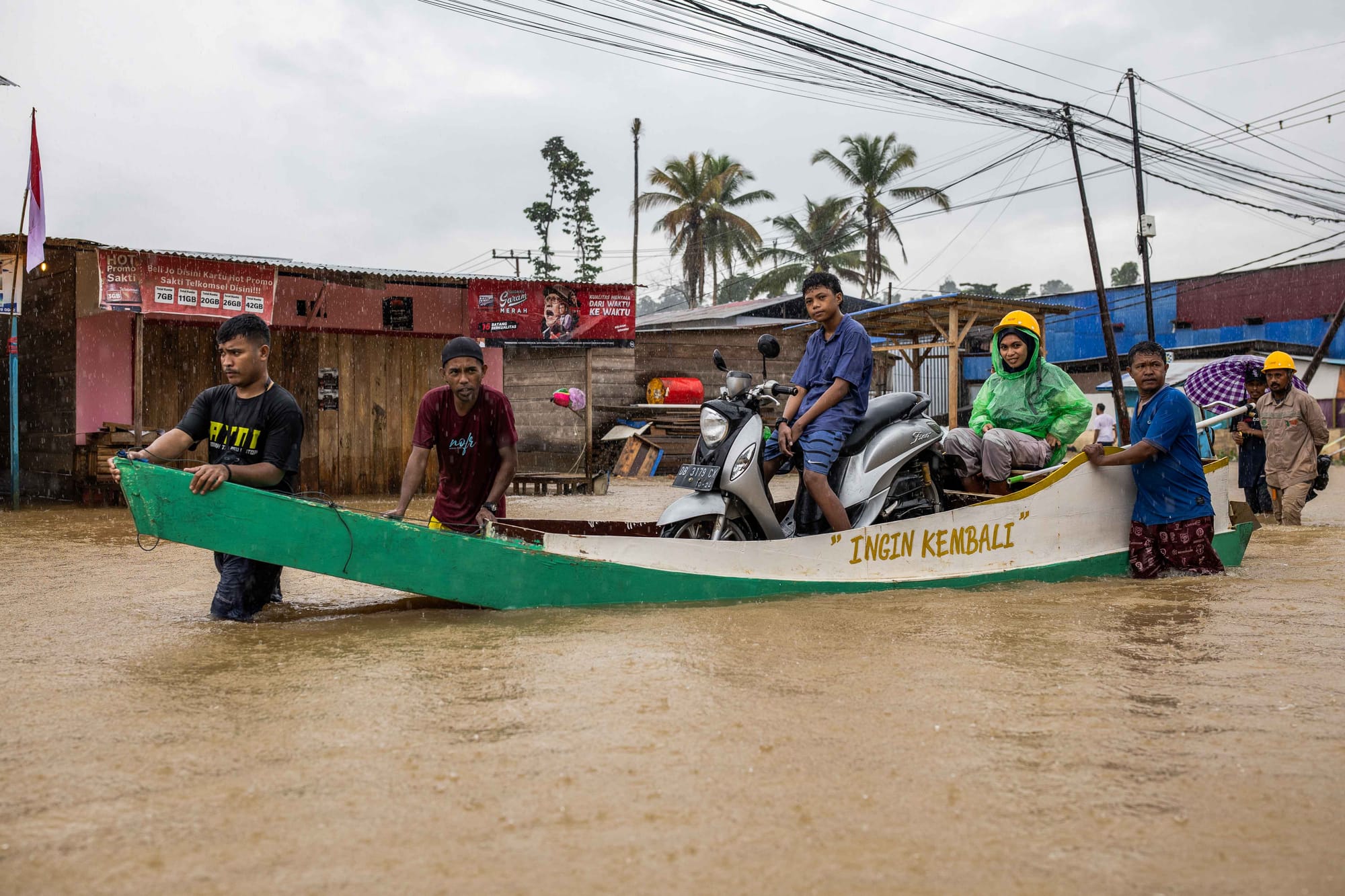
Then Where Will We Live
In Indonesia, nickel mining is booming as global demand for batteries surges. Its impacts—on workers, on communities and on nature—are deeply felt.
Sumean Gebe lives deep in the forests of Halmahera Island in a house he shares with Bede Yuli and their two children. The house is four hours by road from Sofifi, the capital of North Maluku Province. The family are nomadic, moving often around the forest. “We have been like this since we were little,” he told me. “Usually we will make a bivouac with a roof of palm leaves and tarpaulin. We are comfortable living here.”
As the head of the family, Sumean spends his days hunting. The food he catches is then processed in a temporary kitchen made of bamboo. To supplement their income, the family searches the forest for damar resin, which Sumean sells.
Sumean and his family are not alone. On the banks of the nearby Kali Meja River, Etus Hurata and Tatoyo Penes are sago gatherers. Despite their old age, they step agilely through the plantations armed with bamboo sticks and machetes. They are joined by Daniel Totabo, a fisherman looking for eels in the fast-flowing river. When the dry season comes the volume of water in the river drops, a sign that he can look for fish in the deeper currents; the further he searches, the more fish he gets.


Left: Daniel Totabo catches an eel in the Halmahera rainforest, North Maluku, Indonesia. Right: Sumean Gebe posing after hunting.
All are part of the O’Hongana Manyawa people, the “people of the forest” in their native language. Also called Tobelo Dalam, they are one of the only remaining nomadic hunter-gatherer tribes left in Indonesia. They have long depended on the dense forests of Halmahera, which offers them both sustenance and protection. According to Survival International, there are around 3,500 people left in the forested interior of Halmahera; of those, some 300 to 500 O’Hongana Manyawa people have managed to avoid direct contact with outsiders.
That is soon to change. Huge tracts of land on Halmahera have been allocated to mining companies. In some areas the excavators are already at work.
Indonesia is currently undergoing a nickel rush. The country’s 17,000 islands contain the world’s largest reserves of nickel ore, which is often found in shallow deposits whose extraction requires extensive deforestation. As the global transport sector shifts from fossil fuels to clean energy, the demand for electric vehicles has exploded, and with it, demand for nickel, an essential component in many EV batteries. As a result, many O’Hongana Manyawa people find themselves on the front line of the climate crisis.
In response to increased global demand, Indonesia’s nickel sector has expanded rapidly in recent years. Pre-tax revenue jumped from 35 trillion rupiah ($2.1 billion) in 2020 to 172 trillion rupiah ($10.3 billion) just three years later. The country is now the world’s largest refiner and miner of nickel. Importantly, these vast reserves are almost all found either in Morowali, on Sulawesi Island, and here in North Maluku, on Halmahera.
Based on digital maps of the affected areas, at least four mining companies are operating within a 100-kilometre radius of Halmahera. That number will only increase as global demand rises.

Sumean does not want the mining companies to come. “If it continues like this,” he says softly, “the forests in Halmahera will be destroyed. The trees will be cut down and the animals will be driven out and die because their homes have been completely cleared. Then where will we live?”
The Indonesian government has taken a practical approach to the problem. Since 1978, they have relocated Indigenous populations in permanent hamlets and villages. In many of these, like Dodaga Village, facilities are inadequate. Locals’ ties to the forest, however, remain strong. Despite the newly permanent housing and land, it was difficult for many to adapt to a sedentary lifestyle. Many abandoned the village, to be replaced by immigrant workers.
“The house is very hot during the day and very cold at night because it uses a zinc roof. It is different from a leaf roof,” said Sumean. “We did get a house, but maybe they forgot that we must also find our own food every day.”
At points, there have been glimmers of hope for people like Sumean. In May 2024 Tesla took a firm stance in its 2023 Impact Report, claiming to have communicated with policy makers, non-profit organizations and other parties involved in the nickel mining chain in Indonesia to propose a no-go zone for mining systems in order to protect the rights of uncontacted peoples. Yet the EV company has been quiet since, and around 13 per cent of the nickel that the company uses continues to be mined in Indonesia.
Around six hours by road from Dodaga lies the Indonesia Weda Industrial Park (IWIP). Along the way, the densely forested Halmahera plain abruptly ends, the forests beside the road replaced by coal-fired power plants and nickel smelters. Thick smoke from chimneys continues to billow, making the already cloudy sky even darker.
This industrial area, a joint venture between the state-owned PT Aneka Tambang and the Indonesian firm Strand Minerals, began operating in 2020. They were soon joined by the French mining company Eramet as well as the Chinese stainless-steel company Tsingshan Holding Group. Over time, Tshingsan took control of 57 per cent of Stand Minerals shares; Eramet took the rest.
Since November 2020 the area has been included in the National Strategic Project, a set of high-priority infrastructure and development projects and a key pillar of Indonesia’s development strategy. It is predicted to attract investment worth around $15 billion (Rp232.9 trillion) from private firms and several Chinese partners.

Long before the construction of IWIP, the Indonesian government touted the idea of developing the Weda Bay as a nickel production complex. That the mountainous area to the north of IWIP is rich in nickel reserves was no secret. The result, alongside the smoke belched out by the twelve new coal-fired power plants that now dot the area, has been rapid deforestation of the bay.
Queues of trucks carrying materials to and from the mines snake along the road, visible up to 10 kilometres away, and dozens of pieces of heavy equipment are at work digging the hills that run alongside it. Geospatial analysis research conducted by Climate Rights International (CRI) and the AI Climate Initiative at the University of California, Berkeley revealed that nickel mining activities on the island of Halmahera have so far destroyed 5,331 hectares of tropical forest, releasing approximately 2.04 million metric tons of greenhouse gases that had been absorbed by the dense foliage.
A few hundred metres up the road a constant stream of thousands of workers clad in yellow helmets and grimy blue overalls traverse back and forth on their way to work. The wet roads, often little more than dirt tracks, are difficult to navigate. Some use pick-up trucks. One worker said that he spends as much as Rp1 million per month to get from his house in Lelilef Waibulan Village to the PT IWIP Smelter, eight kilometres away—around one sixth of the average monthly wage.
The area currently employs around 43,000 workers. Workers are divided into two shifts, morning and night, which change every day at six pm. In total, each worker will spend half their day at work.
The long hours and heavy workload increase the risk of accidents. Data collected by the Mining Advocacy Network (JATAM) from 2018 to 2024 recorded 42 fatalities due to work accidents in the area. That number increased to 125 in 2022. As one worker told me, the actual number is far higher still.


Left: A waste processing facility at Indonesia Weda Bay Industrial Park. Right: Trucks loaded with nickel ore headed to a smelter at Indonesia Weda Bay Industrial Park.
The area is divided in two, separated by a provincial road. Nickel processing and mining activities are on the side leading to the hills; supporting facilities such as ports, power plants, offices, and airports gather in the coastal region. Not far away are settlements for local residents, and huts for workers.
The huts were built for factory employees who come from outside the Weda area. These are located close to the smelter and to the chimneys of the power plant. The area is dirty and stuffy. The space between huts is slim and there’s little by way of ventilation. In some places, garbage is left to pile up in the open spaces. The grass and plants growing around it are covered in road dust. It is here that workers spend their time before and after their shifts.
Since IWIP first began operations five years ago, workers have lived side by side with the megaproject, in the direct line of its ecological impacts. In part due to the widespread upstream deforestation, floods and landslides are common.
As the latest report from JATAM shows, floods of more than one metre occurred more than 12 times between August 2020 and June 2024. The largest flood occurred in July and August of last year, submerging seven villages and completely cutting off vehicle access, forcing around 1,670 residents into tents.
One of those affected was Ahmad Kruwet. Originally from Tegal, a city in central Java, he now lives in Woe Jarana Village. In July his house was submerged in the largest flood since 2004. “At that time, many houses were swept away, and yesterday there was another flood with the same effect,” he said. “The forest upstream has been cut down until it is completely gone.”
His house is still in disarray, with a television and other items piled high. Several of his livestock were also swept away in the current. “When the flood came, I only thought about saving myself, but I always made sure all the doors to the house were closed, only then could I run to the mountain.”

Ahmad added that he could no longer rely on the groundwater around his house. For the past three or four years, since IWIP began operating, he has had to buy the water he needs. The community has regularly filed complaints about the flooding, and the government built embankments on several sides, but even these could not withstand the heavy waters. Some compensation is given, mainly in the form of basic necessities, when flooding has occurred. The main problems and vulnerabilities, however, remain.
In Lukolamo Village, Adrian Patapata has faced a similar fate. “Before, the water in our house was still clean and fresh,” he said. “We drank with this water. After the mine came here, the water could no longer be used. Let alone drinking, we couldn’t even bathe.” Not only that, he told me, but the bathroom and laundry area had been swept away by the flooding.
When I met the head of the nearby Lelilef Waibulan 2 Health Centre, Asjuati, he told me that the areas directly adjacent to industrial sites had also seen a large increase in cases of upper respiratory infection.[1] This was one of the most heavily affected areas, with the number of new cases almost doubling in just the six months to July 2024. The sufferers are mainly children, as well as the elderly and those who work in the mines. Every day, almost 40 per cent of patients who come to the health centre are workers.
The mining companies have taken certain steps to address the problem, one of which was to collaborate with the health centre in procuring medicines and oxygen cylinders for workers. However, this has far from solved the underlying problem. “I hope they can provide a waste disposal solution that does not harm the community,” Asjuati told me.
Data released by the mining company Eramet shows that around 6,000 hectares of the total 45,065-hectare concession granted to the industrial park in Halmahera will be mined over a 25-year period.[2] At present, as many as 2,000 hectares have already been exploited, both for the construction of new smelters and for mining. The explosion of mining activity and associated deforestation are straining on the complex ecosystems that sustain the health of local agricultural land and plantations. Many farmers have experienced crop failures, often due to declining water and soil quality, and some because their land has been submerged in mud following a flood.

In his plantation in the Trans Kobe area, Adrian could only stare as he watched his coconut and cocoa trees destroyed by flood water. He had long farmed his small 5.5 hectare plantation alongside members of his family. “Before the flood I could plant bananas and sweet potatoes. Now I can’t anymore,” he told me. “When it is already flooded and muddy like this, the roots absorb too much water. Now it is just left like that, the children don’t clean the garden because not much is growing anymore.”
Similar situations are repeated along the coastline, where the expansion of mining activity and the contamination of liquid waste and heavy metals from the smelter has polluted the estuary, the bay and the area’s beaches, where local fishermen trawl.

One afternoon, Hernemus Takuling left his boat on the beach. He has not since returned to sea. He could have fished on the beach, he told me, but he was reluctant to do so; about a hundred metres from where he was standing a pipe from the smelter could be seen discharging waste into the sea, turning the water a brownish yellow.
Hernemus and other fishermen from the coastal villages were forced to travel further to get better quality fish and avoid exposure to contamination. Some even fish around other islands. “I rarely fish here,” he said. “Usually, I take the closest boat four kilometres from the end of the beach, where the fishing is much better.”

He leaves home at four in the morning and returns late the next night. Often, he only gets a few fish for his troubles. It was different, Hernemus told me, when he could still go to sea on the edge of the beach. “Now I need more time and energy just to catch fish. Moreover, I must buy diesel for boat fuel. When I get fish, it’s sometimes hard to sell. In the end, I just eat it alone with my family.”
Only 20 minutes from Smelter B, a large bridge stretches over the Sagea River, which divides the Sagea Village area from North Weda. Many residents use the clear river flow to meet their household needs. The river also provides fish for the locals.
However, even this lifeline has not been safe from the mines. The river has turned a murky reddish yellow colour due to contaminants at least five times since the start of 2024. The clearing of land upstream of the Sagea River Basin has caused soil erosion, which is then carried down the river to more populated areas.

The river is also connected to Boki Maruru Cave, a vital source of water for the people of Central Halmahera and host to the longest underground river cave system in Indonesia. The area has not yet been granted official legal protection by the government despite proposals from the community, and three companies are known to have mining concessions around the cave. In 2023 the Indonesian government was forced to close the area due to the pollution in the water surrounding the cave.
The residents of Sagea have not been passive. While their livelihoods are threatened, they are fighting back. In addition to regular protests, many have been campaigning to include the cave within the National Geopark, which presently protects dense, highly biodiverse tropical forests and several endemic species. They see this as a first step in protecting the local ecosystem from pollution and exploitation.
In addition, residents have urged the government to evaluate nickel mining permits and to restore the river to its original state. As those most affected, residents like Ahmad and Adrian hope that the government can find a way to resolve the problems. “I have experienced conditions like this for years and maybe now I am used to it,” said Ahmad, “but I still want to live a healthy and better life.”
- For instance, the Morowali Industrial Estate in Central Sulawesi and the Weda Bay Industrial Estate in North Maluku have both seen an increase in acute respiratory infections in the surrounding areas.
- The size of this concession is nearly a fifth of the total area of the Central Halmahera Regency (roughly 227,000 hectares)
Garry Lotulung is a photojournalist and documentary photographer based in Jakarta, Indonesia. He specializes in stories about the human condition, social change, and the environment.
